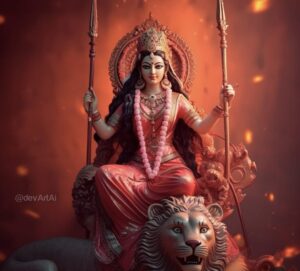Saraswati Devi is one of the principal goddesses in Hinduism, celebrated for her embodiment of knowledge, art and music. She is venerated as the divine source of wisdom and creativity and holds a special place in the hearts of students, scholars and artists. Let’s delve deeper into the essence of Saraswati Devi and her significance.

The Cosmos in Chaos
In the Beginning
In the beginning, the cosmos was a realm of chaos, existing in a formless and fluid state. Brahma, the creator, pondered over how to bring order to this disorder.
Devi’s Divine Proclamation
The Call for Knowledge
In response, Devi, the embodiment of wisdom, spoke, “With Knowledge.” Devi emerged from Brahma’s mouth, riding a swan and heralded by a peacock, holding sacred books in one hand and a veena in the other. She was dressed in white and became known as Saraswati, the goddess of knowledge.
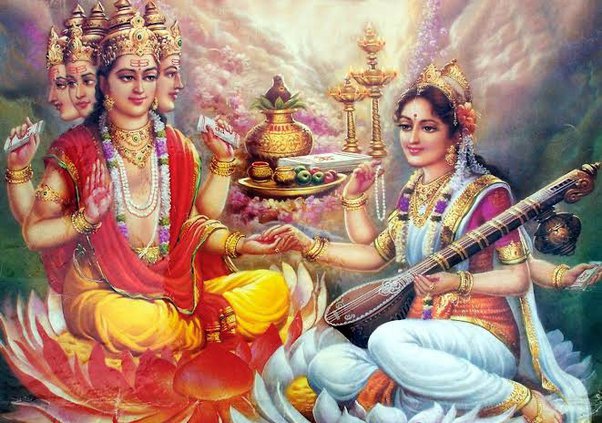
The Gift of Wisdom
Unlocking Possibilities
Devi shared her wisdom with Brahma, emphasizing that knowledge could help him find possibilities amidst the existing problems. Under her guidance, Brahma gained new perspectives and abilities, enabling him to perceive hidden potential within the chaos.
The Birth of Vagdevi
Goddess of Speech and Sound
Brahma, inspired by Saraswati, discovered the harmonious melodies of mantras within the chaotic cacophony. He named Saraswati “Vagdevi,” the goddess of speech and sound. Mantras filled the universe with vital energy, known as prana, shaping the cosmos.
The World Takes Shape
Order from Chaos
With newfound wisdom, the cosmos began to take shape. The sky became the heavens, the sea found its place in the abyss and the Earth stood in between. Gods, demons and humans found their realms as life followed the rhythm of creation.
Brahma’s Pursuit of Wisdom
Infatuation and Transformation
Brahma was infatuated with Saraswati, but was reminded by her that her wisdom should be used to elevate the spirit, not to indulge the senses. Despite her admonition, his infatuation grew and he adorned himself with four heads to keep her in his sight.
Saraswati’s Curse and Brahma’s Infatuation
When Desire Meets Divine Wisdom
Saraswati, angered by Brahma’s unbridled passion, cursed him. She felt he had saturated the world with longing, the root of unhappiness and that he had bound the soul to the flesh.
This curse resulted in only two temples dedicated to Brahma in India. Undeterred by the curse, Brahma continued to cast amorous glances at Saraswati, even giving himself a fifth head to ensure he never missed her presence.
Saraswati’s Elusive Forms
Chasing Wisdom
Saraswati transformed into various creatures to elude Brahma’s pursuit, with each transformation met by Brahma assuming a corresponding male form. Their pursuit continued, highlighting the importance of seeking wisdom over material desires.
Shatarupa: The Goddess of Multiple Forms
Personifying Material Reality
Saraswati, known as Shatarupa, symbolized material reality—enticing yet transient. This tale serves as a timeless lesson on the pursuit of wisdom and knowledge.
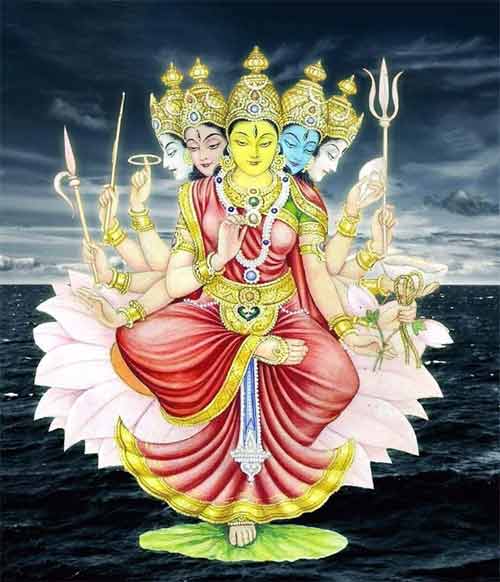
Bhairava, Shiva’s Wrath and Wisdom’s Redemption
The Consequences of Uncontrolled Desire
Brahma’s unrelenting passion disrupted the harmony of the cosmos and drew the attention of Shiva, the supreme ascetic. Shiva’s rage transformed him into Bhairava, the lord of terror.
In his terrifying form, Bhairava tore off Brahma’s fifth head. However, Brahma’s severed head clung to Bhairava, draining his strength and driving him mad.
Saraswati came to Bhairava’s rescue, restoring his sanity. She also shared with Brahma the wisdom needed for his liberation.
Brahma, seeking redemption, decided to conduct a yagna, a fire sacrifice. This required the assistance of a wife, so he chose Saraswati as his partner, and they reconciled.
Saraswati’s Influence: The Song of the Gandharva
The Power of Wisdom through Music
When the Gandharvas, demigods born from the fragrance of flowers, stole the Soma plant, it enraged all the gods. Saraswati intervened to recover the Soma plant, using her veena to create enchanting melodies.

In exchange for the music, Saraswati demanded that the Soma plant be returned to the gods. The Gandharvas agreed and learned the art of music from her, becoming celestial musicians whose melodies could rouse the mind more effectively than any intoxicant.

Saraswati’s Cunning Triumph Over a Demon
Outwitting Desire with Wisdom
A demon’s intense austerities were on the verge of granting him invincibility. Fearing the consequences, the gods sought Saraswati’s help. She sat on the demon’s tongue, limiting his request to “I want to never stay awake.”
Granting his request, Brahma said, “So be it.” The demon, now destined to sleep forever, abandoned his ambition to conquer the three worlds.
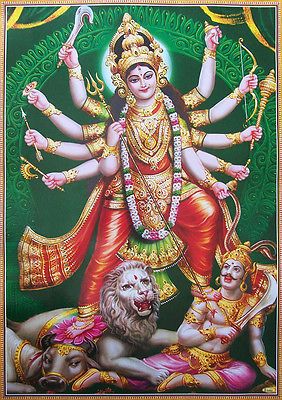
The Complementary Roles of Saraswati and Lakshmi
Balancing Wealth and Wisdom
Brahma, the creator, harnessed the power of Saraswati’s knowledge to establish and maintain dharma, sacred laws that sustain societal stability and growth. But he also relied on the support of Lakshmi, the goddess of wealth, to provide the necessary means for executing his plans.
The question arose: who was more essential, Lakshmi or Saraswati? Wealth or knowledge? Saraswati argued that knowledge gave meaning to life, while Lakshmi claimed that wealth sustained it. Brahma concluded that both knowledge and wealth were essential for living a complete life.
Saraswati Saves the World from Shiva’s Wrath
Wisdom Averts Cosmic Destruction
Shiva, awakened from his meditation, saw a world teetering on the brink of corruption and ruin. He decided it was time to cleanse the slate. Shiva opened his world-destroying third eye, releasing a destructive fire that threatened all existence.

Amid the panic, Saraswati reassured all, explaining that Shiva’s fire only consumed impurity and corruption. She transformed into a river, using her pure waters to contain Shiva’s devastating fire, known as Badavagni.
Saraswati prophesied that as long as the world remained pure and humanity wise, the terrible creature, Badavagni, would remain dormant at the bottom of the sea. However, if wisdom were abandoned and corruption prevailed, this beast of doom would resurface, endangering the universe.
Saraswati’s Ethereal Elegance
An Enchanting Vision of Wisdom
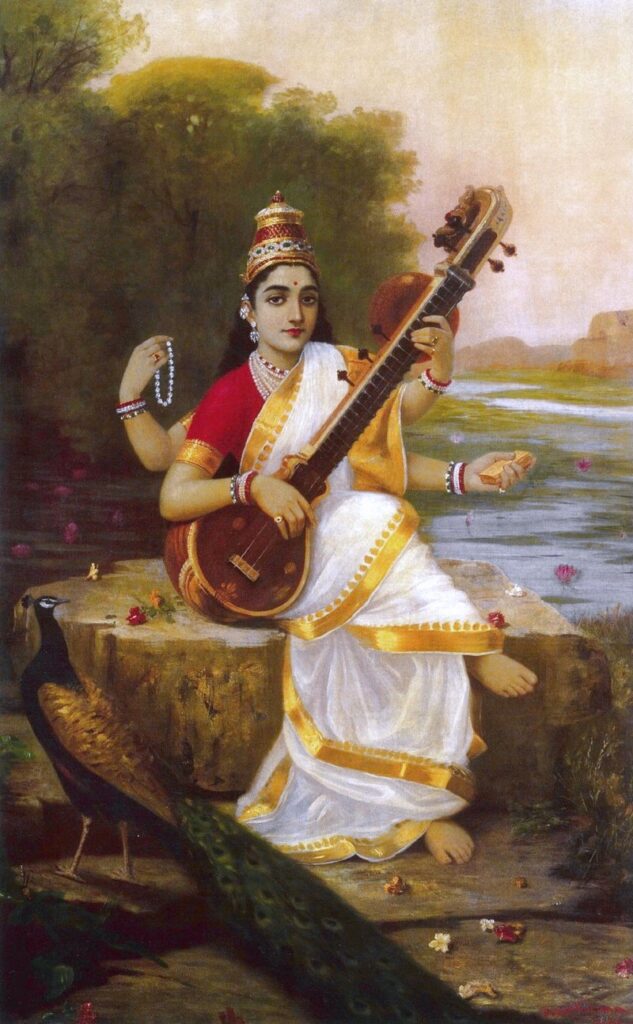
Picture Saraswati, a goddess of exquisite beauty, draped in the purest white attire, seated gracefully on a white lotus. Her very image exudes an aura of purity, knowledge and divine truth. In a world often mired in chaos, she is a symbol of illuminating clarity.
The Dhyana Mantra: A Visual Symphony
An All-White Portrait of Divine Beauty
The Dhyana mantra unveils a vision of Saraswati akin to the luminous moon. She dons a resplendent white dress adorned with graceful white ornaments. Clutched in her elegant hands are a book and a pen. The book is a profound representation of the vast sea of knowledge she embodies.
The Goddess with Four Arms
Harmony in Symbolic Diversity
Saraswati typically appears with four arms, each bearing significant emblems. These four arms symbolize different facets of human existence, mirroring the four heads of her consort, Brahma. They represent the mind, intellect, imagination and self-awareness.
A Symbolic Arsenal in Her Hands
Objects of Profound Significance
Saraswati’s hands grasp items of immense symbolism:
- Pustaka (Book): This sacred tome embodies the Vedas, representing universal, eternal and divine knowledge, as well as all forms of learning.
- Mālā (Rosary): A garland of crystals, signifying the power of meditation, inner contemplation and spiritual depth.
- Water Pot: This vessel symbolizes the purifying force that distinguishes right from wrong, essential from non-essential. Some interpretations cast it as a symbol of soma, the liberating elixir leading to enlightenment.
- Musical Instrument (Veena): Her enchanting veena encapsulates the realms of creative arts and sciences. Holding it signifies the expression of knowledge that creates harmonious melodies.
The Graceful Hamsa Companion
Discernment and Spiritual Attainment
By Saraswati’s side, a hamsa, often a swan or a goose, stands as a companion. In Hindu lore, the hamsa’s unique ability to drink milk from a mixture with water symbolizes its power to distinguish good from evil, the eternal from the transient. This association leads to Saraswati being hailed as “Hamsavāhini.”
The Radiance of the Peacock
Vivid Splendor and Alchemical Transformation
From time to time, Saraswati is portrayed beside a majestic peacock, sometimes called Citramekhala or Mayura. This splendid bird symbolizes vibrant beauty, the exuberance of dance and the transformative power that can turn inner poison into radiant enlightenment.

Saraswati’s portrayal is more than just art; it is a profound story etched in symbols. Each element of her image resonates with layers of meaning, unfolding the depth of her character and significance in the rich tapestry of Hindu culture.
The Serenity of Wisdom
Saraswati’s Pure Essence
Saraswati’s purity shines through her simplicity. She wears a white sari, adorned with neither jewels nor vibrant colors. Her attire reflects her rejection of the materialistic and base aspects of life.
Saraswati transcends worldly desires, rejoicing in the realm of pure wisdom. She symbolizes all that is pristine and noble in the natural world.
Offspring of Knowledge: The Four Vedas
The Divine Lineage of Saraswati
Saraswati, the goddess of knowledge, bestowed the world with the four Vedas, the books of universal knowledge. Her divine mount, the swan, represents pure knowledge, while the peacock, her herald, symbolizes the arts.
In Saraswati’s realm, schools and libraries serve as temples. The tools of artists, musical instruments, books and pens become offerings in devotion to the enlightening goddess of wisdom.
The Harmonious Shield: Saraswati vs. Demons
Music Triumphs over Trickery
In a celestial face-off, two mischievous demons, Vatapi and Ilvala, played a sneaky game with wise sages. They would transform one into a meal and then call him back to life. Saraswati intervened with her divine veena, creating a protective melody that baffled the demons. Their trick failed and their reign of deceit ended.
Method of Wosrship: Goddess Saraswati Devi is traditionally venerated during the auspicious occurrence of the Moola Nakshatra. It is on the 6th day of Navaratri
Puja Vidhi: Fill the ceremonial vessel (kalash) with water. Place five mango leaves inside and gently position a betel leaf over them. Additionally, position an idol of Lord Ganesh next to the Saraswathi idol. Illuminate the lamp in front of Goddess Saraswathi and present her with the sacred offering (Prasad). Don’t forget to include the belpatra and mango leaves as offerings.
Mantras to chant:
Saraswati is revered through various mantras. Chanting these mantras can invoke her blessings and seek her guidance, particularly in matters of knowledge, wisdom and creative expression. Here are a few Saraswati mantras you can chant:
- Saraswati Gayatri Mantra:
- Sanskrit: ॐ वागीश्वर्यै विद्महे वाग्वादिन्यै धीमहि।
- Om Vagishwaryai Vidmahe Vagvadinyai Dheemahi.
- Translation: “Om, let us meditate on the goddess of speech and learning. May she illuminate our minds.”
- Saraswati Moola Mantra:
- Sanskrit: ॐ ऐं वाग्देव्यै च विद्महे कामराजाय धीमहि।
- Om Aing Vaagdevyai Cha Vidmahe Kaamarajaaya Dheemahi.
- Translation: “Om, may we know the goddess of speech and the Lord of Desire. May we meditate upon them.”
- Saraswati Beej Mantra:
- In Sanskrit: ॐ ऐं श्रीं ह्रीं सरस्वत्यै नमः॥
- Om Aim Shreem Hreem Saraswatyai Namah.
- This mantra is a condensed form of worship, focusing on the essential sounds associated with Goddess Saraswati. Chanting this mantra can help invoke her blessings for knowledge and learning.
Prasadam: Ginger Vada, also known as “Allam Garelu” in some regions of India, is a delectable and aromatic South Indian dish. These crispy and flavorful vadas are prepared using urad dal (black gram lentils) and fresh ginger, making them a delightful treat for your taste buds which is served as prasadam for goddess Saraswati.

Astrological Connection: Goddess Saraswati is connected to the planet venus who is the ruler of music and fine arts.
Saraswati in Our Lives
Wisdom in Everyday Life
Saraswati’s wisdom isn’t just a tale from the past; it’s a living inspiration. Her stories guide us on the path of learning and creativity. She reminds us of the power of knowledge and the enduring charm of the arts.
Unraveling the Etymology of Saraswati
Discovering the Name’s Hidden Treasures
The name “Saraswati” is a linguistic gem, comprised of two ancient Sanskrit words: “saras” and “vati.” Together, they paint a vivid portrait of this revered deity.
“Saras” – Pools of Wisdom or Eloquent Speech
The term “saras” is a multi-faceted word that signifies both “pooling water” and, intriguingly, “speech.” It’s as if language itself emerges from the wellspring of wisdom. Saraswati is, after all, the goddess of knowledge and eloquence.
“Vati” – The Possessor of Abundance
“Vati” is an expression of possession, meaning “she who possesses.” In the case of Saraswati, she is the possessor of knowledge, wisdom, and the power of speech.
So, when we unite these elements, “Saraswati” becomes “she who has ponds, lakes, and pooling water,” or in a metaphorical sense, “she who possesses speech.” The name encapsulates her essence as the deity of wisdom, knowledge, and eloquent expression.
From River Deity to Goddess of Knowledge
The term “Saraswati” also has a historical journey. In the Rigveda, it initially referred to the Sarasvati River, signifying a river deity. The Rigveda later lauds Saraswati as the best of mothers, rivers and goddesses.

Over time, her image transforms from a river goddess to a divine figure associated with healing and purifying powers, particularly through flowing waters. The waters, the mothers, cleanse and purify, as she is hailed as the “possessor of knowledge.”
In the evolution of Saraswati’s significance, she progresses from the waters that purify to the very embodiment of knowledge, arts, music, language, and more. Her name becomes synonymous with creative work and that which purifies the essence and self of an individual.

Her Names, Her Essence
Saraswati is known by a myriad of names in ancient Hindu texts, each revealing a facet of her multifaceted character. From Brahmani, the power of Brahma, to Vagdevi, the Goddess of speech, these names reflect her diverse attributes and the profound impact she has on knowledge, wisdom and the arts.
Ultimately, Saraswati’s name transcends the mere sum of its linguistic parts, embracing a spiritual concept of a goddess who guides, inspires and purifies the essence and soul of all those who seek her wisdom and grace.
Author,
Sivalenka Neeraja



